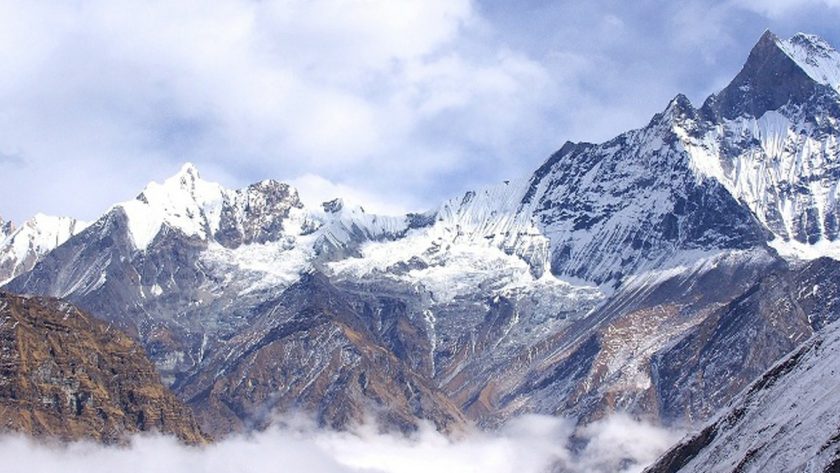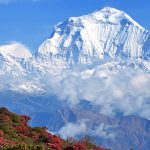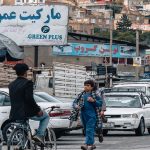“Many a hand has scaled the grand old face of the plateau.”
––Kurt Cobain
It was the boy in the sport coat–one of a handful of Nepali and Tibetan teens hanging around on the grass lawn in front of Kathmandu’s Natural History Museum–who told me the place was closed. Despite his announcement, I stole a peek through a broken window at crocodiles, glass cases marked HIMALAYAN BUTTERFLIES, and signs pointing toward the amphibian and avian collection. Intrigued, I swore to come back again when the museum was open. But when I turned my back to the red brick building, I paused. The group of boys smiled up at me, curious. They sat scattered about with the sun behind them. More than half of these young men were smoking; one boy played a guitar. The boy in the sport coat invited me to join them, to sit and listen to some music. Remembering the harmonica tucked in my backpack, I walked toward them and sat down.
The pocket Hohner had been a hit with younger children just a few days ago when we could not find a common language. I pulled out the trusty harmonica but merely fiddled with it in my hands. Many of these older children spoke English quite well, and I was a bit intimidated to perform: I could not play the surprisingly all–too–familiar tunes: Bob Marley’s “No Woman No Cry,” Eric Clapton’s “Wonderful Tonight,” and Pink Floyd’s “Another Brick in the Wall.” According to my sister Sara, who lived in Nepal on a study abroad program during the summer of 1996, the most popular and most requested song was Led Zeppelin’s “Stairway to Heaven.” By late August, Sara was sick of her high–school favorite.
The boys passed the guitar around from lap to lap, taking turns enjoying the music and each other’s talents. One boy played Nepali pop songs while others sang along. The sun warmed their youthful smiles and bronzed skin. Cigarette smoke swirled around them and softened the light. Later, marijuana–pulled from a large stash wrapped in an old Kathmandu newspaper with looping script that spiraled like the smoke–scented the air. The boys were intimate with each other, holding hands, hugging, and sitting close, with arms draped over one another’s shoulders. I’d seen this mannerism in the crowded Kathmandu streets with older men hanging out in the small blue wooden doorways of butcher shops, hardware stalls, and spice nooks. On small stools or in a precariously deep squat, they balanced with the support of a friend. Seeing this affection here made this atmosphere much more relaxed than if I’d been with a group of teenage boys in the United States. In fact, had I known these boys better, it would have been a perfect afternoon to photograph what I call “album–cover shots.” The scene was gentle eye candy, but since the ear candy was sweeter, I resolved to leave the camera in the bag. Between songs, our communication was light and friendly. Occasionally, a boy would ask if I was bored. “No,” I’d answer and sit back on my hands, content and smiling. I shifted the arrangement of my crossed feet (heavy with muddied hiking boots) and just soaked up the scene. The singing and smiling was delightful. I was captive. I was present. I was enjoying the listening, the observing, and the learning.
I learned that three of these boys were Tibetan and lived just below this hill in a refugee village called Kim Tole. Since the Chinese invasion of Tibet in 1959, this area of Kathmandu has become home to hundreds of Tibetans in exile. The colorful buildings and rooftops of Kim Tole were backlit by the afternoon sun. They resembled the painted patterns of the gomba of the most photographed and recognizable landmark in Nepal: Swayambhunath. Known as the monkey temple, the Tibetan Buddhist stupa built over 2,000 years ago was located on the hill just above me. You can hike up the 300 steep flagstone steps to the top where Buddha’s eyes (all three of them) meet yours. Swayambhunath is crowned with a gold spire of thirteen disks stacked upon each other, representing the thirteen steps to enlightenment, and an umbrella at the peak symbolizes the attainment of enlightenment. It was only the other day that I’d visited the stupa while a steady morning breeze sent prayers from yellow, white, blue, red, and green prayer flags high into the mountain air.
Today’s breeze sang serenity during the hour or so I stayed with the bunch of boys. One good–looking boy, who ascended up from the lower stairs, cool and confident, joined us. In his leather jacket, he looked like the leader of the pack, if there was one among this casual and creative bunch of friends. He requested the guitar, and as soon as it was given to him, he began to tune it to his liking. As he tuned up, I recognized a not–so–classic riff, one from my college years and from a band close to my hometown.
He played some Nepali classics and some of his other favorite songs. He was an excellent musician. Finally, he played the entire song of the riff he’d tuned to. As he did, a Buddha–like smile crept in at the corners of my mouth. When he finished his rendition, he asked me, “Where in USA do you live?” I smiled into the setting sun and uttered just one word: Seattle.
It was as if I’d whispered “Ohm.” At that moment, it all came together. “Kurt Cobain!” he quickly shouted. Now he was smiling, too. Then, perhaps feeling that I could provide a local’s insight, the leader of the pack pondered aloud, “Why did he kill himself?”
I took a meditative breath. “I’m not quite sure,” I answered, honestly. But as I leaned back into my hands, my palms feeling the cool soil beneath them, all I could think was Nirvana. Here at the base of Swayambhunath, we have all reached Nirvana.



